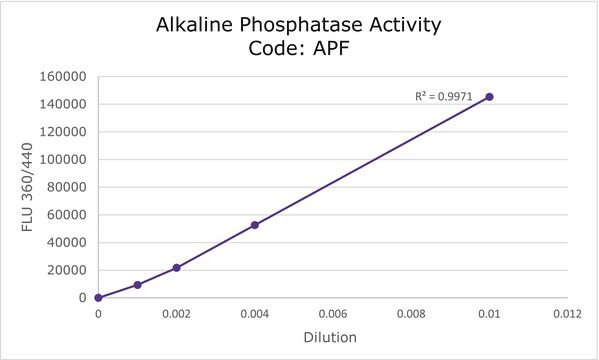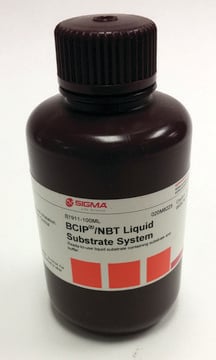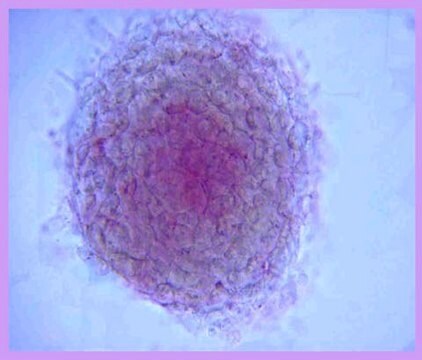SCR066
Quantitative Alkaline Phosphatase ES Characterization Kit
This Quantitative Alkaline Phosphatase Embryonic Stem (ES) Characterization Kit easily quantifies the amount of alkaline phosphatase present within their embryonic stem cell cultures using a convenient 96-well colorimetric enzymatic assay.
About This Item
Prodotti consigliati
Livello qualitativo
Reattività contro le specie (prevista in base all’omologia)
mammals
Produttore/marchio commerciale
Chemicon®
tecniche
cell culture | stem cell: suitable
input
sample type: human embryonic stem cell(s)
sample type cardiac stem cell(s)
sample type neural stem cell(s)
sample type hematopoietic stem cell(s)
sample type epithelial cells
sample type mesenchymal stem cell(s)
sample type pancreatic stem cell(s)
sample type: mouse embryonic stem cell(s)
sample type induced pluripotent stem cell(s)
Descrizione generale
Alkaline phosphatase (ALP) is a hydrolase enzyme responsible for dephosphorylating molecules such as nucleotides, proteins, and alkaloids under alkaline conditions. The enzyme is present within all tissues of the body but is elevated in cells of the liver, kidney, bone, placenta, embryo and under specific disease states. Under alkaline conditions (pH>10), ALP can catalyze the hydrolysis of p-nitrophenylphosphate (p-NPP) into phosphate and p-nitrophenol, a yellow colored by-product of the catalytic reaction. The amount of p-nitrophenol produced is proportional to the amount of alkaline phosphatase present within the reaction. The amount of ALP can thus be reliably quantified by reading the amount of p-nitrophenol amassed after the catalytic reaction at 405 nm on a spectrophotometer.
Applicazioni
Stem Cell Research
Componenti
p-NPP Buffer: (Part No. ES011-10ML) 10 mL
Reaction Stop Solution: (Part No.CS200653) 5 mL
1X Wash Solution: (Part No. CS200652) 2 X 125 mL
Recombinant Alkaline Phosphatase Standard: (Part No. CS200654) 0.5 μg (10 μg/mL)
Stoccaggio e stabilità
Note legali
Esclusione di responsabilità
Avvertenze
Danger
Indicazioni di pericolo
Classi di pericolo
Aquatic Chronic 3 - Eye Dam. 1 - Met. Corr. 1 - Repr. 2 - Skin Corr. 1B
Codice della classe di stoccaggio
8A - Combustible corrosive hazardous materials
Certificati d'analisi (COA)
Cerca il Certificati d'analisi (COA) digitando il numero di lotto/batch corrispondente. I numeri di lotto o di batch sono stampati sull'etichetta dei prodotti dopo la parola ‘Lotto’ o ‘Batch’.
Possiedi già questo prodotto?
I documenti relativi ai prodotti acquistati recentemente sono disponibili nell’Archivio dei documenti.
Il team dei nostri ricercatori vanta grande esperienza in tutte le aree della ricerca quali Life Science, scienza dei materiali, sintesi chimica, cromatografia, discipline analitiche, ecc..
Contatta l'Assistenza Tecnica.









